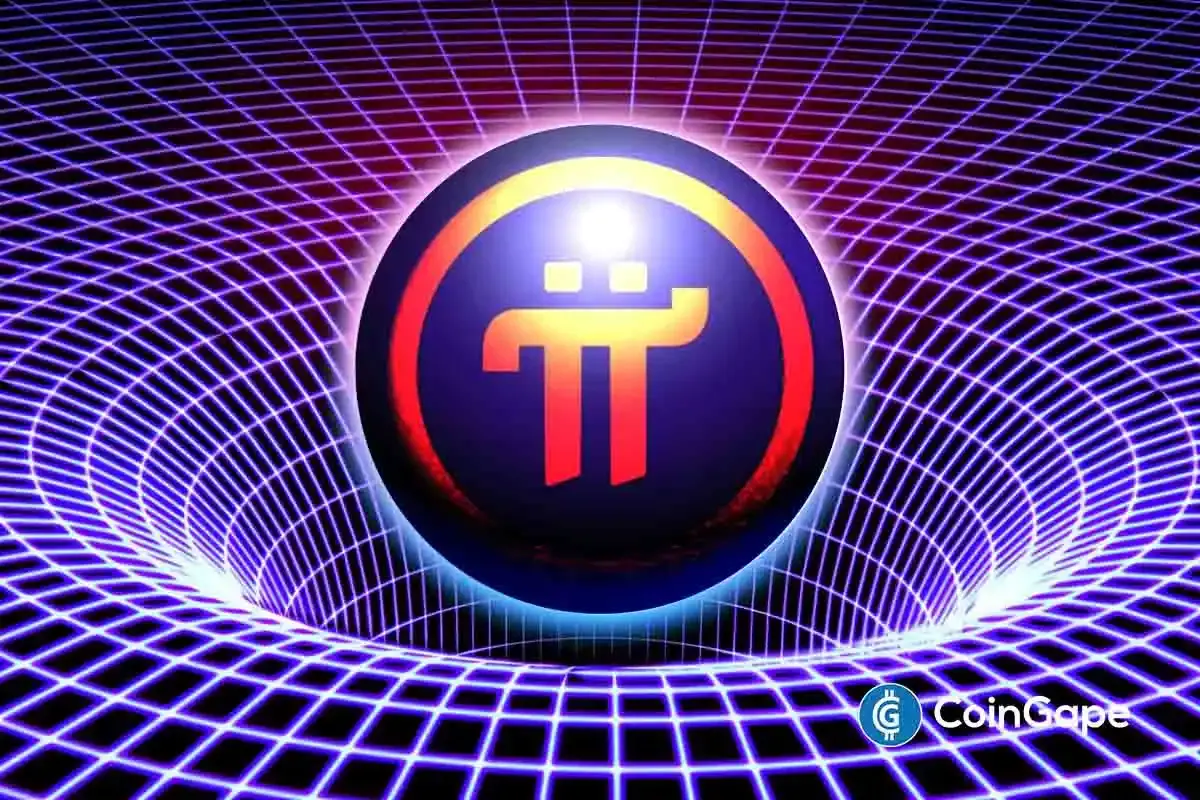Market
Wormhole (W) Jumps 10%—But Is a Pullback Coming?

Wormhole (W) surged nearly 12% on Thursday after the project unveiled its official product roadmap. The project’s one-year anniversary has sparked speculative interviews.
However, technical data shows buyers and sellers locked in a fierce battle, as momentum indicators suggest a weakening trend. The DMI, Ichimoku Cloud, and EMA structures all reflect market indecision, with no clear direction confirmed just yet.
Wormhole DMI Chart Shows Market Indecision
Wormhole’s DMI chart shows its ADX (Average Directional Index) has dropped to 21.69 from 27.59 just a day earlier, signaling that the recent trend may be losing strength.
The ADX is a key indicator used to measure the strength—not the direction—of a trend. Generally, values below 20 suggest a weak or non-existent trend, while values above 25 indicate a strong trend.
With ADX now hovering near the threshold, it suggests that the bullish momentum seen in recent days could be fading.

Looking deeper, the +DI (Positive Directional Indicator) has fallen to 19.96 after peaking near 24 earlier, though it had surged from 9.68 the previous day.
Meanwhile, the -DI (Negative Directional Indicator) climbed to 18.27 after dropping to 15.21 earlier, following a sharp decline from 30.18 yesterday. This narrowing gap between +DI and -DI—combined with a weakening ADX—suggests uncertainty and potential indecision in price action.
With a $137.64 million token unlock on the horizon, this shift could hint at a cooling bullish impulse and the risk of renewed selling pressure if supply outweighs demand.
Ichimoku Cloud Shows Mixed Signals
Wormhole’s Ichimoku Cloud chart shows a mixed outlook. Price action is attempting to break through resistance but still faces notable headwinds.
The Tenkan-sen (blue line) has recently flattened and is closely aligned with the Kijun-sen (red line), signaling indecision or a potential pause in momentum.
Typically, when these lines are flat and close together, it indicates consolidation rather than a clear trend continuation or reversal.
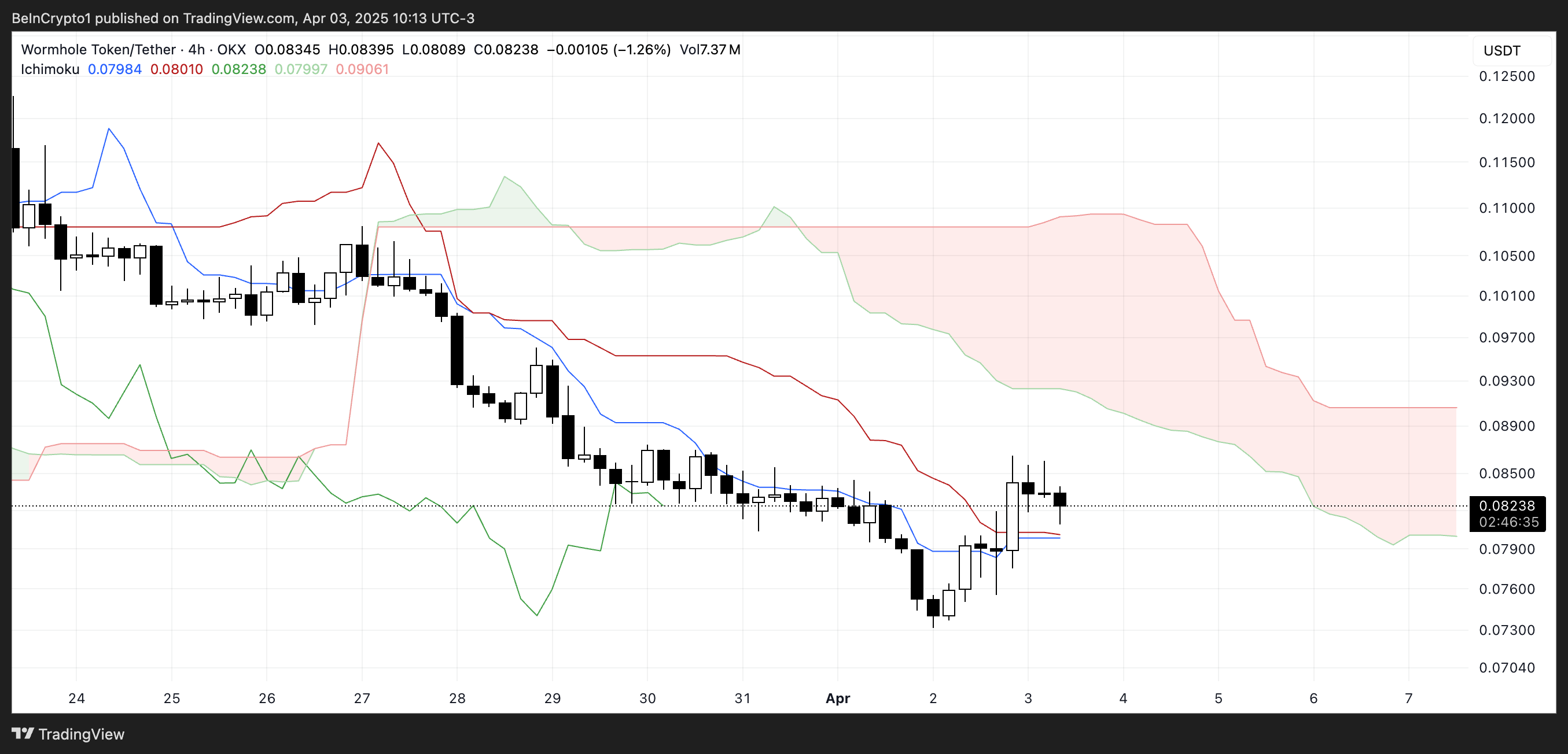
Meanwhile, the Kumo (cloud) remains thick and red ahead, reflecting strong overhead resistance and a bearish long-term bias.
The price is hovering near the lower edge of the cloud but has yet to make a decisive move above it—suggesting that bullish momentum is tentative at best.
For a confirmed trend reversal, a clean break above the cloud with bullish crossovers would be needed. Until then, the chart points to a market still trying to find direction, especially ahead of a major token unlock event that could further impact sentiment and price action.
Will Wormhole Reclaim $0.10 In April?
Wormhole, which builds solutions around interoperable bridges, continues to see its EMA setup reflect a bearish structure. Short-term moving averages are still positioned below the longer-term ones, an indication that downward pressure remains dominant.
However, one of the short-term EMAs has started to curve upward, hinting at a possible shift in momentum as buyers begin to step in. This early uptick could signal the beginning of a trend reversal, though confirmation is still pending.
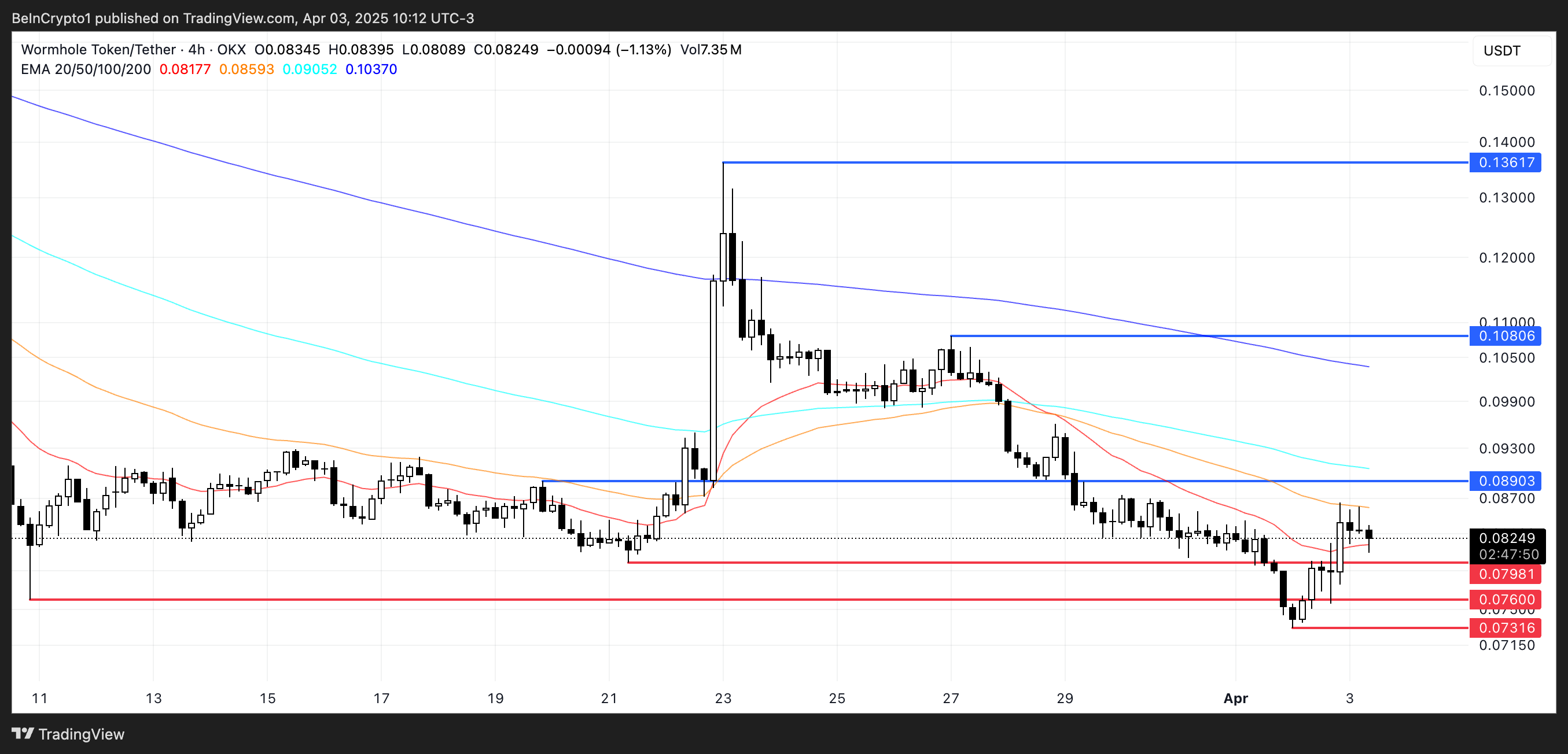
If bullish momentum gains traction, Wormhole may attempt to break the nearby resistance at $0.089. A successful breakout could open the door for a move toward higher resistance levels at $0.108 and even $0.136.
Conversely, failure to clear $0.089 could reinforce bearish control, pushing the price back to test support at $0.079.
A break below that level could expose W to further downside toward $0.076, $0.073, and potentially below $0.07—marking uncharted territory for the token.
Disclaimer
In line with the Trust Project guidelines, this price analysis article is for informational purposes only and should not be considered financial or investment advice. BeInCrypto is committed to accurate, unbiased reporting, but market conditions are subject to change without notice. Always conduct your own research and consult with a professional before making any financial decisions. Please note that our Terms and Conditions, Privacy Policy, and Disclaimers have been updated.
Market
Dogecoin Faces $200 Million Liquidation If It Slips To This Price

Dogecoin (DOGE) price has recently struggled with momentum, failing to break key resistance levels. As of press time, DOGE is holding at $0.169, just above the crucial support of $0.164.
This stagnation hints at the potential for further declines, but key investors are still holding strong.
Dogecoin Is Facing Challenges
The liquidation map reveals that approximately $216 million worth of long positions could face liquidation if Dogecoin’s price declines to $0.150. This price is not far from its current critical support of $0.164.
If DOGE drops below this level, the liquidation of long contracts could fuel a further sell-off, pushing the price lower. This would likely prompt more bearish sentiment among traders, discouraging new investments in the meme coin.
Moreover, the threat of liquidation looms large as the price hovers near critical support levels. If DOGE continues to weaken, traders may be more inclined to exit positions, exacerbating the downtrend.
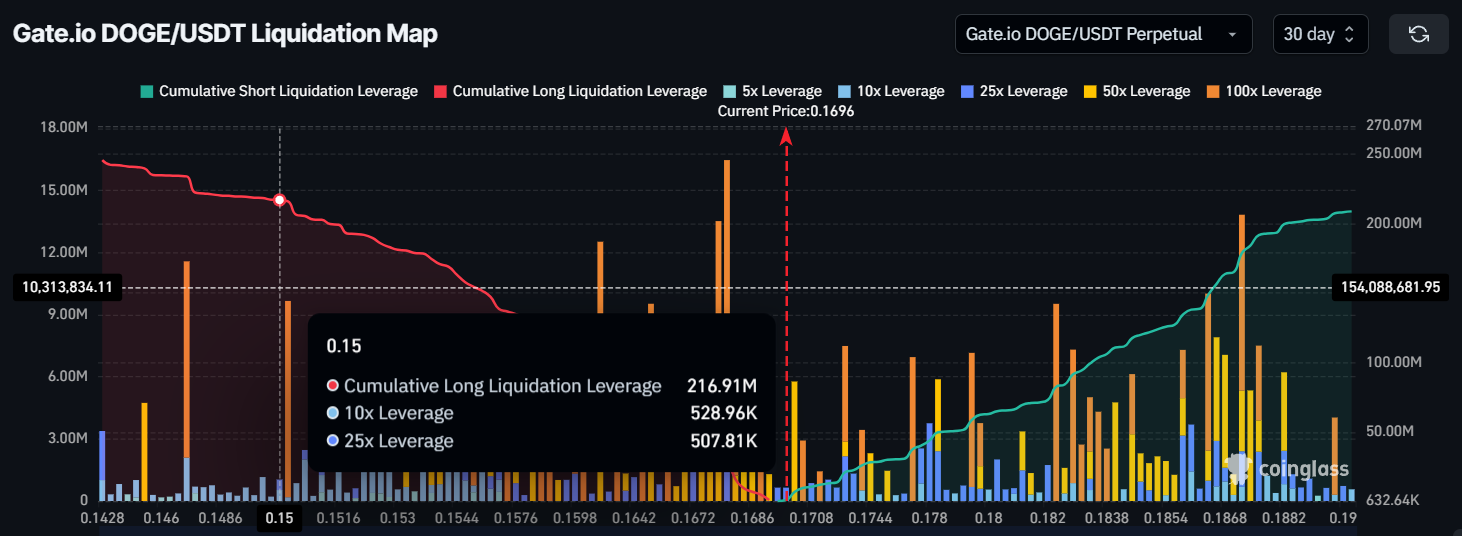
On the other hand, Dogecoin’s long-term holders (LTHs) seem to be focused on accumulating the asset at its current low price.
The HODLer net position change shows an increasing number of LTHs who are confident in eventual price recovery. As DOGE remains relatively inexpensive, these investors view the current conditions as a potential opportunity for future gains.
This accumulation by LTHs could serve as a buffer against further price declines. Their confidence in Dogecoin’s recovery and long-term potential is helping to sustain the current price levels. If these holders continue to accumulate, it could prevent a drastic drop and even pave the way for a future price rebound.
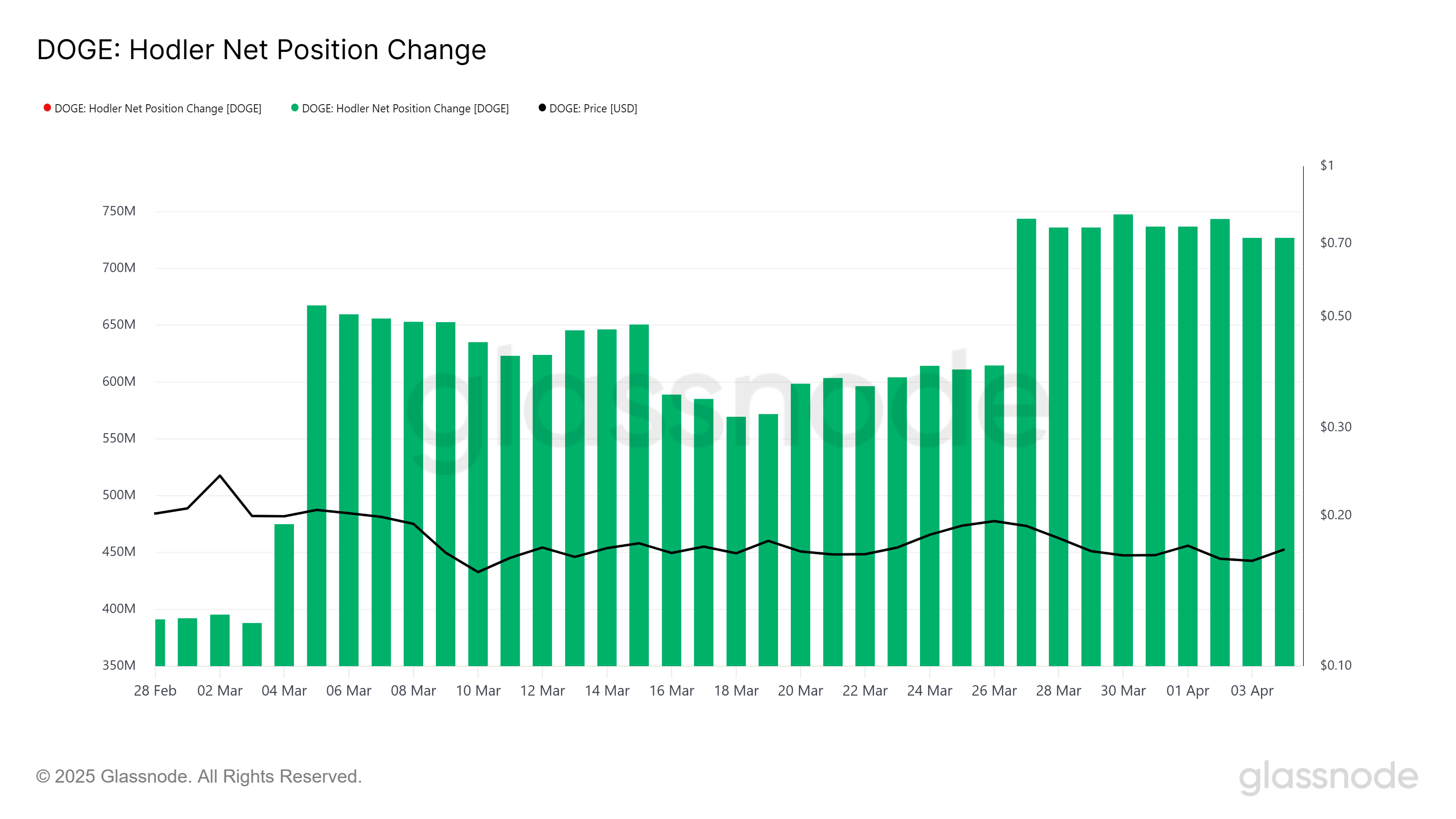
DOGE Price Correction Unlikely
At the time of writing, Dogecoin is trading at $0.169, just above the critical support of $0.164. The altcoin has been unable to break the $0.176 resistance for several days, showing signs of stagnation.
The likely outcome is continued consolidation above $0.164 as investors await a potential catalyst for upward movement.
If Dogecoin manages to breach the $0.176 resistance, it could quickly rise to $0.198, marking a positive shift in sentiment. This would likely encourage more buying activity and help push the price higher.
However, without sufficient momentum, DOGE will remain trapped within its current range, potentially facing further consolidation.

If the price falls below $0.164, it could slip to $0.147 in the coming days, triggering more than $216 million in long liquidations. This scenario would signal a shift toward bearish momentum, invalidating Dogecoin’s bullish outlook.
The coming days will be crucial in determining whether DOGE can recover or continue its decline.
Disclaimer
In line with the Trust Project guidelines, this price analysis article is for informational purposes only and should not be considered financial or investment advice. BeInCrypto is committed to accurate, unbiased reporting, but market conditions are subject to change without notice. Always conduct your own research and consult with a professional before making any financial decisions. Please note that our Terms and Conditions, Privacy Policy, and Disclaimers have been updated.
Market
SEC’s Crypto War Fades as Ripple, Coinbase Lawsuits Drop

Since US President Donald Trump assumed office, the Securities and Exchange Commission (SEC) has dropped, settled, or paused lawsuits against prominent crypto entities left and right. In stark contrast to the previous administration’s leadership under Chair Gary Gensler, the SEC seems to be parting from its previous crackdown on digital assets.
In an interview with BeInCrypto, Nick Puckrin, Founder of The Coin Bureau, and Hank Huang, Chief Executive Officer at Kronos Research, highlighted the substantial election influence the crypto industry had over Trump’s candidacy as a contributing factor to the SEC’s looser stance on crypto.
The SEC’s Approach Under Trump
The SEC has experienced a clear shift in its approach to crypto lawsuits under Trump’s presidency. Its move away from the aggressive enforcement tactics of its previous leadership has largely characterized this shift.
“When President Donald Trump won the US election, the crypto industry rejoiced. Finally, the ‘regulation by enforcement’ era, which the SEC under the leadership of Gary Gensler was so famous for, was about to come to an end. And the new administration didn’t disappoint. Within just a couple of weeks of Trump’s inauguration, the revamped SEC started dropping lawsuits against crypto firms left, right and center,” Puckrin said.
Two weeks ago, the SEC officially dropped its appeal and XRP lawsuit against Ripple Labs, ending a five-year legal battle. The Commission had originally accused Ripple of conducting an unregistered securities offering worth $1.3 billion through XRP sales.
“After more than four years in limbo, the SEC has officially decided that XRP is not a security (though what it is instead remains to be seen). This case has been weighing heavily on XRP – the fourth largest cryptocurrency with a market cap of roughly $130 billion– so its resolution is a major win,” Puckrin added.
The wider crypto community celebrated the outcome, with many arguing that it will set a precedent for how digital assets are classified in the US. This prediction is warranted, given that the SEC has been on a lawsuit-dropping spree.
Ripple and Coinbase Cases Mark Significant Wins
Shortly before ending the Ripple lawsuit, the SEC dropped its legal battle against Coinbase. The case also centered on whether Coinbase should be classified as a security.
“The SEC is clearly retreating from its once-aggressive stance on crypto, as seen in its 2025 dismissal of lawsuits against Ripple, Coinbase, and others. This shift, driven by the crypto-friendly and pro-business Trump administration, signals a future of more streamlined and transparent US crypto regulation,” Huang told BeInCrypto.
The SEC has also dropped several ongoing investigations against OpenSea, Robinhood, Uniswap Labs, Kraken, and Gemini. It has also asked a federal court to issue a 60-day pause over its litigation against Binance. Meanwhile, the Commission settled its investigation into ConsenSys over its Ethereum software products.
These lawsuits surfaced in parallel to a series of crypto-friendly measures meant to foster greater innovation and curb potential regulatory suffocation that had existed during the Biden era.
Will New Leadership Define Clear Crypto Regulations?
A day after Trump assumed office, SEC Acting Chairman Mark Uyeda announced the creation of a dedicated crypto task force led by Commissioner Hester Peirce. The task force was reportedly designed to resolve long-standing ambiguities in the regulatory treatment of digital assets.
In all SEC crypto lawsuits, Commissioner Uyeda has implemented a strategy prioritizing industry engagement to develop regulatory frameworks that balance innovation and investor protection.
Meanwhile, Trump strategically nominated Paul Atkins, a crypto-curious, regulation-light candidate, to replace Gensler as head of the SEC. Just this week, the Senate Banking Committee voted to advance Atkins’ nomination to the full Senate.
“Driven by Republican principles, the SEC under Trump could implement clearer crypto guidelines by 2025, reduce regulatory burdens, and roll back Biden-era policies that have stifled innovation by 2027. This could mark the beginning of treating most digital assets as commodities,” Huang said.
Now, only a stone’s throw away from becoming SEC Chair, Atkins is expected to loosen regulatory oversight on crypto.
“With the establishment of a new Task Force and key appointees like Paul Atkins fostering innovation, Trump’s strategic move to create a Bitcoin reserve within the government further underscores his commitment to supporting the industry. The future of crypto regulations will be focused on less oversight and the beginning of a delicate but promising thaw in the regulatory landscape,” Huang added.
Though some say Trump’s handling of crypto affairs has resulted in a never-before-seen triumph, others are weary that his increasing involvement in the industry has turned out to be a recipe for disaster.
The Impact of Crypto Donations on Regulations
Several industry leaders went to great lengths to ensure that Trump became America’s 47th president. Millions of dollars in donations from crypto firms throughout Trump’s campaign illustrated these efforts.
According to a Public Citizen report, over $119 million from crypto corporations went into influencing the 2024 federal elections, largely through Fairshake, a non-partisan super PAC backing pro-crypto candidates and opposing skeptics.

Coinbase and Ripple, among others who stand to profit, directly provided over half of Fairshake’s funding. The remaining funds mostly came from billionaire crypto executives and venture capitalists. Notable contributions included $44 million from the founders of Andreessen Horowitz, $5 million from the Winklevoss twins, and $1 million from Coinbase CEO Brian Armstrong.
So far, big crypto’s spending strategy is paying off with a more favorable environment.
“Political donations from the crypto industry during the 2024 election, particularly to pro-crypto candidates like Trump, played a significant role in shaping the SEC’s 2025 decision to drop lawsuits against crypto firms. These contributions helped align the administration with the industry’s interests and influenced Congress, driving about 50-60% of the shift,” Huang told BeInCrypto.
Without a clear framework to guide the crypto industry following these dropped lawsuits, this lax approach risks being short-lived. Ultimately, this could tarnish long-term crypto adoption.
Meme Coin Scams Highlight Deregulation Dangers
According to Puckrin, the success of the dropped lawsuits was obscured by the lack of regulations that have led to the proliferation of high-profile meme coin scams.
“Somehow, all these victories feel somewhat hollow after the reputation of the crypto industry has been tarnished by the billions of dollars in combined losses from meme coin scams. Meanwhile, Hayden Davis, the mastermind behind LIBRA, continues to launch fraudulent meme tokens, despite being on the Interpol wanted list,” he said.
A 2024 report by Web3 intelligence platform Merkle Science revealed that meme coin rug pulls cost investors over $500 million. The February LIBRA incident showed how this trend was carried over to 2025. Nansen data revealed that 86% of investors lost $251 million, while insiders pocketed $180 million in profits.
Though crypto scammers may be charged with related crimes like wire fraud or money laundering, rug pulling is legal. Better said, it’s unaccounted for. No regulation holds crypto insiders responsible for meme coin scams.
“As crypto becomes an ever more mainstream asset class, consumers need to be protected against those who choose to use it for nefarious purposes. One way to do this is through education, and that’s our job as an industry. But deterring scams and extractive behavior is the job of the regulators. And it’s time they stepped up to the task,” Puckrin told BeInCrypto.
If the SEC doesn’t take advantage of this opportunity to curb the consequences that meme coin scams can produce, it will result in an enormous setback for the industry.
Comprehensive Regulation Beyond Dropped Lawsuits
Puckrin illustrated the need for heightened regulatory clarity in crypto by drawing attention to the way the SEC penalizes insider trading in the context of traditional investing.
“In traditional investing, insider trading is a serious crime. In the US, it’s punishable by fines of up to $5 million for individuals and prison sentences up to 20 years. Similarly, federal penalties for engaging with illegal gambling activities include up to five years in prison. Perpetrators of memecoin scams must be punished with the same level of severity, because the result is the same: manipulating markets and cheating unsuspecting investors out of their savings,” he said.
Puckrin clarified, however, that the issue isn’t solely about penalizing fraudsters. Just as the SEC’s past overregulation hindered the industry, the current lack of meme coin rules creates an environment where new scams and exploitative schemes can easily flourish.
“Yes, the removal of lawsuits is great news for blockchain innovation, but something needs to replace it. Indeed, serious cryptocurrency firms have never advocated for an unregulated Wild West. What they want is clarity and rules that are fit for the nascent blockchain industry – not just a copy-and-paste of existing financial regulations that simply don’t work for crypto,” he said.
Although the Trump administration has only been in place for four months, the clock is ticking, and meaningful change takes time.
Unanswered Questions Loom
Puckrin expressed concern over the current administration’s prioritization of lawsuit dismissals instead of working faster to implement transcendental crypto regulation.
“My concern is that regulators will keep kicking the can down the road with crypto regulation, having gained the approval of the industry for dropping the many lawsuits that were stifling its growth. And this is incredibly dangerous,” he told BeInCrypto.
Meanwhile, critical questions that only the SEC can define remain unanswered.
“What are memecoins and who will ensure another LIBRA fiasco doesn’t happen? Are utility altcoins now commodities and if so, will the Commodities Futures Trading Commission (CFTC) regulate them? And, importantly, what do we do about compensating investors who have lost billions to crypto fraud?” Puckrin concluded.
The SEC’s current direction promises a regulated renaissance or a breeding ground for future crises.
With billions lost and critical questions unanswered, the future of crypto hinges on whether the regulatory body will translate its recent shift into a lasting framework that fosters innovation without sacrificing investor protection.
Disclaimer
Following the Trust Project guidelines, this feature article presents opinions and perspectives from industry experts or individuals. BeInCrypto is dedicated to transparent reporting, but the views expressed in this article do not necessarily reflect those of BeInCrypto or its staff. Readers should verify information independently and consult with a professional before making decisions based on this content. Please note that our Terms and Conditions, Privacy Policy, and Disclaimers have been updated.
Market
PayPal Adds Support for Solana and Chainlink


PayPal has expanded its cryptocurrency offerings in the US by adding support for Solana (SOL) and Chainlink (LINK).
These tokens join PayPal’s existing lineup, which includes Bitcoin (BTC), Ethereum (ETH), Litecoin (LTC), Bitcoin Cash (BCH), and its native stablecoin, PYUSD.
PayPal’s Crypto Expansion Highlights Rising Demand for Solana and Chainlink
Both Solana and Chainlink play critical roles in the blockchain space. Solana supports fast, low-cost transactions and is widely used in decentralized finance (DeFi), gaming, and Web3 applications.
Chainlink, on the other hand, is essential for enabling smart contracts to access real-world data through decentralized oracles.
According to BeInCrypto data, the two assets currently rank among the top fifteen cryptocurrencies by market capitalization. This makes them strategic additions to PayPal’s crypto offering.
May Zabaneh, PayPal’s Vice President of Blockchain and Digital Currencies, explained that the update reflects strong user demand for more crypto options.
According to Zabaneh, the goal is to give users greater flexibility and more ways to interact with digital assets across PayPal’s ecosystem.
“Since we initially made cryptocurrencies available on PayPal and Venmo, we’ve been listening to our users about what they want to do with crypto on our platforms. One piece of feedback we’ve heard is to make additional tokens available that align with our mission of revolutionizing payments,” Zabaneh stated.
Meanwhile, PayPal’s latest move comes as the company strengthens its presence in the digital asset space. With over 434 million active users and a 45% share of the global online payments market, PayPal is in a strong position to influence how mainstream users engage with crypto.
Moreover, industry experts see this integration as a logical next step. Max Hamilton, an investment researcher at Foresight Ventures, noted that legacy companies like PayPal enjoy deep trust, regulatory experience, and extensive networks. These advantages make them well-positioned to incorporate crypto without losing ground to newer competitors.
“Established giants like [PayPal] wield an unparalleled advantage in distribution, a moat built over decades of customer acquisition, merchant relationships, and regulatory compliance And we continue to see them co-opting crypto offerings into their ecosystems so as to not be displaced by them,” Hamilton stated.
PayPal first entered the crypto space in 2020, allowing users to buy and hold Bitcoin and Ethereum.
Since then, the company has deepened its involvement in the emerging sector by launching PYUSD, a dollar-pegged stablecoin, on Ethereum in 2023.
In 2024, it expanded PYUSD to the Solana network. This move helped boost the stablecoin’s circulating supply to $733 million as of press time.
Earlier this year, the company revealed plans to embed PYUSD more deeply into its ecosystem. This includes enabling merchants to accept it for payments and expanding use cases across its platforms.
Disclaimer
In adherence to the Trust Project guidelines, BeInCrypto is committed to unbiased, transparent reporting. This news article aims to provide accurate, timely information. However, readers are advised to verify facts independently and consult with a professional before making any decisions based on this content. Please note that our Terms and Conditions, Privacy Policy, and Disclaimers have been updated.
-

 Market24 hours ago
Market24 hours agoWill the SEC Approve Grayscale’s Solana ETF?
-

 Ethereum22 hours ago
Ethereum22 hours agoEthereum Whales Buy the Dip – Over 130K ETH Added In A Single Day
-

 Bitcoin22 hours ago
Bitcoin22 hours agoVitalik’s L2 Roadmap, XRP Unlock and More
-

 Altcoin19 hours ago
Altcoin19 hours agoAnalyst Predicts XRP Price To Reach Double Digits By July 21 Cycle Peak
-

 Market20 hours ago
Market20 hours agoPEPE Price Breaks Ascending Triangle To Target Another 20% Crash
-

 Market23 hours ago
Market23 hours agoPENDLE Token Outperforms BTC and ETH with a 10% Rally
-

 Market17 hours ago
Market17 hours agoNFT Market Falls 12% in March as Ethereum Sales Drop 59%
-

 Altcoin20 hours ago
Altcoin20 hours agoPi Network Under Fire As PiDaoSwap Launches NFTs On Binance Chain













